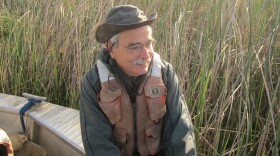Federal officials say water from Friant Dam may connect to the ocean this summer. But some people aren’t so sure it’ll happen.
As part of one of the largest restoration projects in the country groups will begin working this summer to fully connect water flowing out of Friant Dam in the San Joaquin River to the Sacramento-San Joaquin Delta and out to the ocean.

“It’s going to look like a small stream, a couple of inches, maybe a foot or more in some deeper pools,” says Alicia Forsythe with the San Joaquin River Restoration Program.
The group hopes to eventually restore a salmon run on this river that in some spots has been dry for more than five decades. Forsythe says in order for flows from Friant Dam to reach where the Merced River dumps into the San Joaquin River sand will have to be removed from portions of the dry waterway. She also says a group of animals thought to be the endangered kangaroo rat may need to be relocated.
“We need to take some time to survey those burrows and do some trapping to see if it’s the listed or not listed kangaroo rat and work through that concern,” Forsythe says.

Not everyone is so sure water from Friant will actually make it to the Pacific this summer. Nick Zanninovich, who manages water releases from Friant Dam, says the river is too dry and there won’t be enough snowmelt to do the job.
“Even on warmer days we’re not seeing that result in higher flows coming down the river,” says Zanninovich. “With that I think it’s going to reduce allocations potentially to the restoration program later this season.”
Zanninovich says if Central California has a normal wet season this coming winter he expects the waterway to fully connect the summer of 2017.






